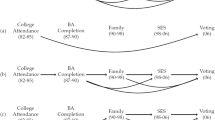Abstract
This paper presents a goal-oriented model of political participation based on two psychological assumptions. The first is that people are more altruistic towards individuals that agree with them and the second is that people’s well-being rises when other people share their personal opinions. The act of voting is then a source of vicarious utility because it raises the well-being of individuals that agree with the voter. Substantial equilibrium turnout emerges with nontrivial voting costs and modest altruism. The model can explain higher turnout in close elections as well as votes for third-party candidates with no prospect of victory. For certain parameters, these third party candidates lose votes to more popular candidates, a phenomenon often called strategic voting. For other parameters, the model predicts “vote-stealing” where the addition of a third candidate robs a viable major candidate of electoral support.
Similar content being viewed by others
References
Abramson, P. R., Aldrich, J. H., Paolino, P., & Rhode, D. W. (1992). ‘Sophisticated’ voting in the 1988 presidential primaries. American Political Science Review, 86(1), 55–69.
Alvarez, R. M., & Nagler, J. (2000). A new approach for modelling strategic voting in multiparty elections. British Journal of Political Science, 30(1), 57–75.
Andreoni, J. (1989). Giving with impure altruism: Applications to charity and Ricardian equivalence. Journal of Political Economy, 97(6), 1447–1458.
Bartels, L. M. (1987). Candidate choice and the dynamics of the presidential nominating process. American Journal of Political Science, 31(1), 1–30.
Blais, A. (2000). To vote or not to vote? Pittsburgh: University of Pittsburgh Press.
Blais, A., Nadeau, R., Gidengil, E., & Nevitte, N. (2001). The formation of party preferences: Testing the proximity and directional models. European Journal of Political Research, 40(1), 81–91.
Brady, H. E., & Sniderman, P. (1985). Attitude attribution: A group basis for political reasoning. American Political Science Review, 79(4), 1061–1078.
Brennan, G., & Buchanan, J. (1984). Voter choice: Evaluating political alternatives. American Behavioral Scientist, 28(2), 185–201.
Brennan, G., & Lomasky, L. (1993). Democracy and decision. Cambridge: Cambridge University Press.
Byrne, D. (1961). Interpersonal attraction and attitude similarity. Journal of Abnormal and Social Psychology, 62(3), 713–715.
Cain, B. E. (1978). Strategic voting in Britain. American Journal of Political Science, 22(3), 639–655.
Copeland, C., & Laband, D. N. (2002). Expressiveness and voting. Public Choice, 110(3–4), 351–363.
Cox, G. W. (1997). Making votes count. Cambridge: Cambridge University Press.
Downs, A. (1957). An economic theory of democracy. New York: Harper and Row.
Farrell, J., & Saloner, G. (1985). Standardization, compatibility, and innovation. RAND Journal of Economics, 16(1), 70–83.
Feddersen, T. J., & Sandroni, A. (2006). A theory of participation in elections. American Economic Review, 96(4), 1271–1282.
Ferejohn, J., & Fiorina, M. (1974). The paradox of not voting, A decision theoretic analysis. American Political Science Review, 68(2), 525–536.
Foster, C. B. (1984). The performance of rational voter models in recent presidential elections. American Political Science Review, 78(3), 678–690.
Fowler, J. H. (2006). Altruism and turnout. Journal of Politics, 68(3), 674–683.
Gerber, A. S., Green, D. P., & Larimer, C. W. (2008). Social pressure and voter turnout: Evidence from a large scale field experiment. American Political Science Review, 102(1), 33–48.
Geys, B. (2006). Explaining voter turnout: A review of aggregate-level research. Electoral Studies, 25(4), 637–663.
Jankowski, R. (2002). Buying a lottery ticket to help the poor. Rationality and Society, 14(1), 55–77.
Kanekar, S., & Merchant, S. M. (2001). Helping norms in relation to religious affiliation. Journal of Social Psychology, 141(5), 617–626.
Karylowski, J. (1976). Self-esteem, similarity, liking and helping. Personality and Social Psychology Bulletin, 2, 71–74.
Kenworthy, J. B., & Miller, N. (2001). Perceptual asymmetry in consensus estimates of majority and minority members. Journal of Personality and Social Psychology, 80(4), 597–612.
Knack, S. (1992). Civic norms, social sanctions, and voter turnout. Rationality and Society, 4(2), 133–156.
Lacy, D., & Burden, B. C. (1999). The vote-stealing and turnout effects of Ross Perot in the 1992 U.S. presidential election. American Journal of Political Science, 43(1), 233–255.
Markus, G. B., & Converse, P. E. (1979). A dynamic simultaneous equation model of electoral choice. American Political Science Review, 73(4), 1055–1070.
Milgram, S., Mann, L., & Harter, S. (1965). The lost-letter technique: A tool of social research. Public Opinion Quarterly, 29(3), 437–438.
Montoya, R. M., & Horton, R. S. (2004). On the importance of cognitive evaluation as a determinant of interpersonal attraction. Journal of Personality and Social Psychology, 86(5), 696–712.
Pool, G. J., Wood, W., & Leck, K. (1998). The self-esteem motive in social influence: Agreement with valued majorities and disagreement with derogated minorities. Journal of Personality and Social Psychology, 75(4), 967–975.
Riker, W. H., & Ordeshook, P. C. (1968). A theory of the calculus of voting. American Political Science Review, 62(1), 25–42.
Rotemberg, J. J. (2008). Minimally acceptable altruism and the ultimatum game. Journal of Economic Behavior and Organization, 66(3–4), 457–476.
Schuessler, A. A. (2000). Expressive voting. Rationality and Society, 12(1), 87–119.
Sole, K., Marton, J., & Hornstein, H. A. (1975). Opinion similarity and helping: Three field experiments investigating the bases of promotive tension. Journal of Experimental Social Psychology, 11(1), 1–13.
Tucker, L., Hornstein, H. A., Holloway, S., & Sole, K. (1977). The effects of temptation and information about a stranger on helping. Personality and Social Psychology Bulletin, 3(3), 416–420.
Uhlaner, C. J. (1989). Turnout: The neglected role of groups. American Journal of Political Science, 33(2), 390–422.
Author information
Authors and Affiliations
Corresponding author
Rights and permissions
About this article
Cite this article
Rotemberg, J.J. Attitude-dependent altruism, turnout and voting. Public Choice 140, 223–244 (2009). https://doi.org/10.1007/s11127-009-9422-2
Received:
Accepted:
Published:
Issue Date:
DOI: https://doi.org/10.1007/s11127-009-9422-2




